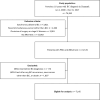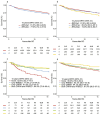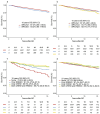Timely germline BRCA testing after invasive breast cancer promotes contralateral risk-reducing mastectomy and improves survival: an observational retrospective study
- PMID: 40408052
- PMCID: PMC12134039
- DOI: 10.1007/s10549-025-07726-2
Timely germline BRCA testing after invasive breast cancer promotes contralateral risk-reducing mastectomy and improves survival: an observational retrospective study
Abstract
Purpose: To report the rates of risk-reducing surgery (RRS) following germline testing for BRCA1/2 (likely) pathogenic variants (BRCApv) and to assess the impact of RRS and BRCA status on survival after surgical treatment for unilateral breast cancer (BC).
Methods: We identified 7145 women with BC (2000-2017), a BRCA test and median follow-up of 10.8 years from the Danish Breast Cancer Cooperative Group's clinical database. Distant recurrence-free (DRFS) and overall survival (OS) according to BRCA status were evaluated using the Kaplan-Meier method. Hazard ratios (HR) for BRCApv vs. BRCA wild-type, contralateral risk-reducing mastectomy (CRRM), and risk-reducing bilateral salpingo-oophorectomy (RRBSO), including interaction tests, were estimated using multivariable Cox models.
Results: Among BRCA1pv carriers (n = 403), CRRM rates were higher than in BRCA2pv (n = 317) (66% vs. 52%, p < 0.001) and more likely to receive timely testing, i.e., within 6 months of BC diagnosis (75% vs. 52%, p = 0.004). Regarding RRBSO rates, no differences were observed. CRRM was associated with significantly improved DRFS (HR = 0.63, 95% CI 0.51-0.78) and OS (HR = 0.64, 95% CI 0.51-0.82), independently of BRCA status and age. RRBSO was associated with improved OS only in BRCApv carriers, specifically, those aged ≥ 50 years (HR = 0.44, 95% CI 0.26-0.75). BRCApv (irrespective of affected gene) was associated with worse DRFS (HR = 1.31, 95% CI 1.06-1.63); however, this was only evident after 2 years of follow-up (HR = 1.53, 95% CI 1.22-1.93). BRCApv was not significantly associated with worse OS (HR = 1.25, 95%CI 0.98-1.58).
Conclusion: Timely germline testing at BC diagnosis might increase CRRM rates in BRCApv carriers, thereby improving survival.
Keywords: Contralateral mastectomy; Danish breast cancer cooperative group; Genetic screening; Hereditary breast cancer; Risk-reducing surgery.
© 2025. The Author(s).
Conflict of interest statement
Declarations. Conflict of interest: AK and AL: Institutional grants from AstraZeneca. Personal grants (presentation): AstraZeneca; AVL: Advisory board: MSD, congress attendance support: Daiichi Sankyo, AstraZeneca; MJ: Meeting expenses and advisory board, Novartis; BE: institutional grants from AstraZeneca, Eli Lilly, MSD, Novartis, Pfizer, and Roche; grants for attending scientific meetings from MSD and Daiichi Sankyo; advisory board member organized by Eli Lilly and Medac. IP: Personal grant (presentation): AstraZeneca. KW: Personal grant (presentation), Seagen Denmark ApS. LCBA and MM are employees of AstraZeneca and hold shares; MT, CMR, and LL report no conflicts of interest. Ethical approval: The study was approved by the board of the Danish Breast Cancer Cooperative Group, the Capital Region’s Center for Health (R-21061634), and the Zealand University Hospital’s Administration Board (EMN-2021–09331). The study is registered at the Capital Region Research Overview – PACTIUS (J.nr. P-2021–0729) and adheres to the General Data Protection Regulations.
Figures



References
-
- Kuchenbaecker KB, Hopper JL, Barnes DR, Phillips K-A, Mooij TM, Roos-Blom M-J et al (2017) Risks of breast, ovarian, and contralateral breast cancer for BRCA1 and BRCA2 mutation carriers. JAMA 317(23):2402–2416. 10.1001/jama.2017.7112 - PubMed
-
- van der Kolk DM, de Bock GH, Leegte BK, Schaapveld M, Mourits MJE, de Vries J et al (2010) Penetrance of breast cancer, ovarian cancer and contralateral breast cancer in BRCA1 and BRCA2 families: high cancer incidence at older age. Breast Cancer Res Treat 124(3):643–651. 10.1007/s10549-010-0805-3 - PubMed
-
- Sessa C, Balmaña J, Bober SL, Cardoso MJ, Colombo N, Curigliano G et al (2023) Risk reduction and screening of cancer in hereditary breast-ovarian cancer syndromes: ESMO clinical practice guideline. Ann Oncol 34(1):33–47. 10.1016/j.annonc.2022.10.004 - PubMed
Publication types
MeSH terms
Substances
LinkOut - more resources
Full Text Sources
Medical
Miscellaneous

